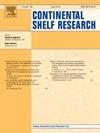Escalating variability of daily sea temperature decreases phytoplankton spring blooms
IF 2.2
3区 地球科学
Q2 OCEANOGRAPHY
引用次数: 0
Abstract
Increases in sea surface temperature (SST) and its variability (SSTV) in the context of climate change have a great impact on marine phytoplankton productivity, but their combined effects on phytoplankton biomass, especially at a daily scale, have been poorly assessed. Here, we used an extended autoregressive (EAR) model to assess the different roles of SST and SSTV on phytoplankton spring blooms (PSB) in the Yellow Sea, based on 25 years (1998–2022) of daily-scale high-resolution chlorophyll-a (Chl-a) data from satellites. The annual patterns of PSB indices (start, peak, and duration) clearly exhibited years which were weak (low peak: Chl-a <0.80 mg/m3; short duration: <15 days) and strong (high peak: Chl-a >1.0 mg/m3; long duration: >60 days). The EAR model detected the significant effects of SST and SSTV on PSB indices, with SSTV being the more important determinant. SST is highly related to the timing of PSB start and end, with the average SST of 9.5 ± 0.7 °C at the start and 13.2 ± 1.95 °C at the end. The amplitude of SSTV was negatively correlated with the daily increase in Chl-a, highlighting the role of SSTV in modulating the magnitude of PSB. At low SST, the deepening of the mixed layer prolonged the time for phytoplankton to equilibrate nutrient and light requirements, whereas at low SSTV, the rate of environmental change within the mixed layer was reduced, allowing phytoplankton to adapt to the environment more quickly. Since the accumulation of phytoplankton biomass depends largely on daily acclimated growth, our results suggest that increasing daily temperature anomalies and warming in future are detrimental to phytoplankton biomass accumulation, and may reduce the magnitude of PSB in mid-to high-latitude seas.
日海温变异性的增加减少了浮游植物的春季繁殖
气候变化背景下海表温度(SST)及其变率(SSTV)的升高对海洋浮游植物的生产力有很大的影响,但它们对浮游植物生物量的综合影响,特别是在日尺度上的影响,目前还没有得到充分的评估。基于25年(1998-2022)日尺度高分辨率叶绿素-a (Chl-a)卫星数据,利用扩展自回归(EAR)模型评估了SST和SSTV对黄海浮游植物春季华(PSB)的不同作用。PSB指数(开始、峰值和持续时间)的年际格局明显表现为弱年份(低峰:Chl-a <;0.80 mg/m3;短持续时间:15天),强(峰值:Chl-a >;1.0 mg/m3;持续时间长:60天)。EAR模型检测到SST和SSTV对PSB指数有显著影响,其中SSTV是更重要的决定因素。海温与PSB开始和结束的时间高度相关,开始时平均海温为9.5±0.7°C,结束时平均海温为13.2±1.95°C。SSTV的幅度与Chl-a的日升高呈负相关,突出了SSTV在调节PSB的幅度中的作用。在低海温条件下,混合层的加深延长了浮游植物平衡养分和光需求的时间,而在低海温条件下,混合层内的环境变化速率降低,使浮游植物能够更快地适应环境。由于浮游植物生物量的积累在很大程度上取决于日适应生长,我们的研究结果表明,未来日温度异常和变暖的增加不利于浮游植物生物量的积累,并可能降低中高纬度海域PSB的强度。
本文章由计算机程序翻译,如有差异,请以英文原文为准。
求助全文
约1分钟内获得全文
求助全文
来源期刊

Continental Shelf Research
地学-海洋学
CiteScore
4.30
自引率
4.30%
发文量
136
审稿时长
6.1 months
期刊介绍:
Continental Shelf Research publishes articles dealing with the biological, chemical, geological and physical oceanography of the shallow marine environment, from coastal and estuarine waters out to the shelf break. The continental shelf is a critical environment within the land-ocean continuum, and many processes, functions and problems in the continental shelf are driven by terrestrial inputs transported through the rivers and estuaries to the coastal and continental shelf areas. Manuscripts that deal with these topics must make a clear link to the continental shelf. Examples of research areas include:
Physical sedimentology and geomorphology
Geochemistry of the coastal ocean (inorganic and organic)
Marine environment and anthropogenic effects
Interaction of physical dynamics with natural and manmade shoreline features
Benthic, phytoplankton and zooplankton ecology
Coastal water and sediment quality, and ecosystem health
Benthic-pelagic coupling (physical and biogeochemical)
Interactions between physical dynamics (waves, currents, mixing, etc.) and biogeochemical cycles
Estuarine, coastal and shelf sea modelling and process studies.
 求助内容:
求助内容: 应助结果提醒方式:
应助结果提醒方式:


